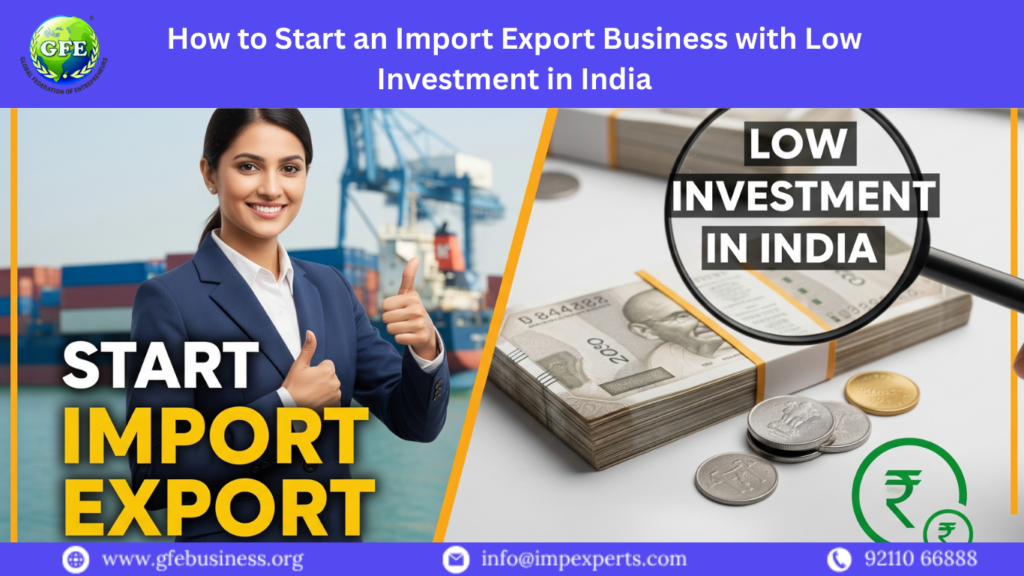
How to Start an Import Export Business with Low Investment in India
Starting an import export business is a dream for many aspiring entrepreneurs in India. The idea of connecting with global markets, selling Indian products abroad, and importing high-demand goods into the country has an exciting appeal. However, one of the biggest misconceptions is that you need a huge amount of capital to get started.
In reality, with the right planning, market knowledge, and professional guidance, you can launch an import export business in India with low investment — and still create a profitable, scalable venture.
In this blog, we’ll explore step-by-step how you can start your trade journey without burning a hole in your pocket. We’ll also highlight the crucial role of expert support from industry professionals like GFE Business in making your startup journey smoother.
Why Start an Import Export Business in India?
Before diving into the low investment strategies, it’s worth understanding why India is one of the best places to start an import export venture:
Growing Global Demand for Indian Products – From textiles to spices, handicrafts to organic foods, Indian goods have a strong global market.
Government Initiatives – Schemes like “Make in India” and export incentives help small traders compete internationally.
Digital Transformation – Online B2B platforms have reduced marketing costs and made international trade more accessible.
Low Entry Barriers – You can start with limited products and expand gradually as your business grows.
These factors make it possible for even small-scale entrepreneurs to start and thrive in the import export industry.
Step-by-Step Guide to Starting with Low Investment
1. Choose the Right Product
Your product selection will determine your startup costs. For a low-investment approach:
Start with lightweight, high-demand items that are easy to ship (e.g., handicrafts, organic spices, handmade jewelry).
Avoid products with high import duties or complicated compliance requirements.
Conduct market research using free tools like Google Trends, trade portals, and social media to understand demand.
2. Identify Your Target Market
Instead of trying to cater to every country, focus on one or two international markets. This reduces:
Marketing costs
Documentation complexity
Risk of overstocking
For example, if you plan to export organic teas, focus on markets where there’s a growing trend toward healthy living, such as the US, Canada, or Europe.
3. Complete Legal Registration
To officially run an import export business in India, you need:
Business Registration – As a sole proprietorship, partnership, LLP, or Pvt. Ltd. company.
IEC (Import Export Code) – Mandatory for cross-border trade.
GST Registration – If your turnover exceeds the threshold or you plan to import goods.
You can complete these processes online with minimal fees, avoiding the need for expensive consultants at the early stage.

4. Build Supplier & Buyer Networks
Instead of stocking large inventory, consider order-based trading:
Partner with manufacturers and suppliers who can produce goods on demand.
Build relationships with overseas buyers through platforms like Alibaba, TradeIndia, or ExportersIndia.
Use LinkedIn and niche forums to find leads instead of spending on costly trade fairs initially.
5. Use Digital Marketing Instead of Traditional Advertising
Rather than investing heavily in print or TV ads, use cost-effective online marketing:
B2B Portals – Free or low-cost listings.
Social Media – Showcase your products on Instagram, LinkedIn, and Facebook.
WhatsApp Business – Share catalogs and product videos with buyers instantly.
This can significantly cut your marketing expenses while still generating quality leads.
How to Reduce Costs Further in Your Import Export Startup
Starting with low investment is about smart resource allocation. Here’s how to keep expenses minimal:
Shared Warehousing – Use third-party logistics providers (3PLs) that offer storage and shipping without long-term commitments.
Drop Shipping Model – Sell products directly from the supplier to the buyer without maintaining inventory.
Free Trade Agreements (FTAs) – Target countries with lower tariffs to reduce cost barriers.
Government Subsidies – Apply for MSME benefits, export incentives, and low-interest loans.
Common Mistakes to Avoid
Many first-time traders fail not because of lack of funds but due to poor planning. Avoid these pitfalls:
Exporting without verifying buyer credentials.
Ignoring international trade compliance rules.
Over-ordering stock without confirmed orders.
Underestimating shipping and customs costs.
By starting small and using low-risk strategies, you can steadily grow your import export business.
Why Professional Guidance is Worth the Investment
Even when you aim for a low-investment startup, having an expert consultant can prevent costly mistakes. Here’s why:
Compliance Support – Avoid fines and shipment delays by getting paperwork right.
Market Insights – Learn which markets and products will work best for your budget.
Network Access – Tap into established supplier and buyer databases.
Faster Setup – Save months of trial-and-error learning.
With a consultant like GFE Business, you can start your import export business efficiently and maximize your profits from day one.
Example Low-Investment Import Export Business Models
Here are a few models you can consider:
Handicrafts Export – Partner with local artisans and sell products internationally without large stock.
Organic Foods – Export organic teas, spices, or herbs with minimal packaging costs.
Apparel & Accessories – Dropship Indian ethnic wear to global customers.
Importing Consumer Goods – Import trending products like gadgets, fitness gear, or beauty items for resale in India.
Final Words: Your Low-Cost Global Business Awaits
Starting an import export business in India with low investment is entirely possible if you take strategic steps:
Pick the right product
Target specific markets
Minimize upfront costs through smart business models
Leverage professional guidance
With a growing global appetite for Indian goods, there has never been a better time to start your journey.
If you want expert help to set up your import export business, get your documentation right, and connect with buyers quickly, GFE Business is your trusted partner for export business setup services in India.